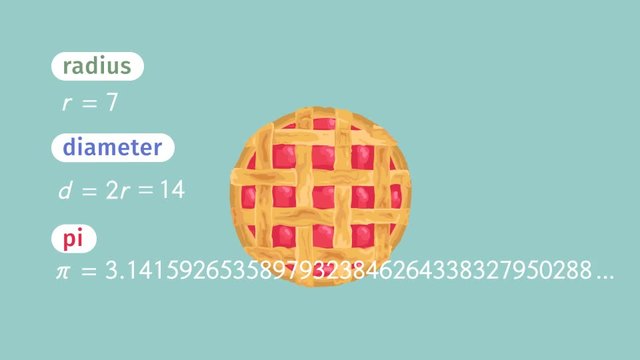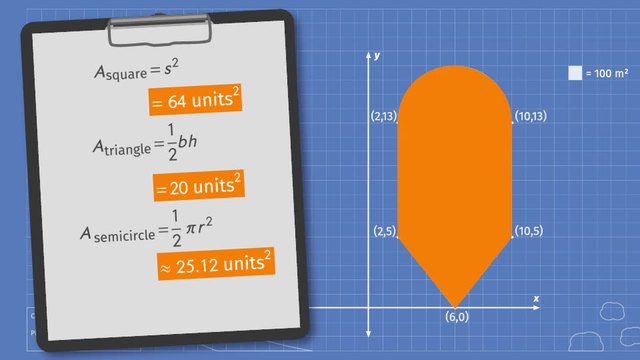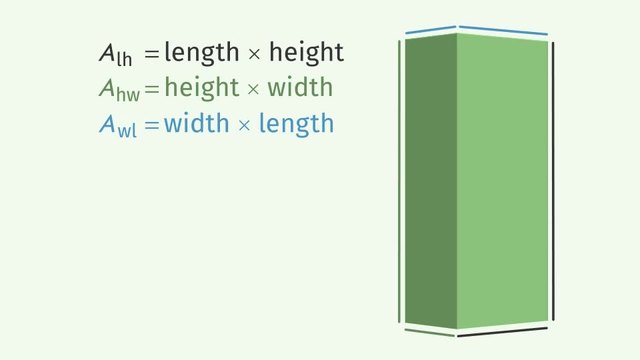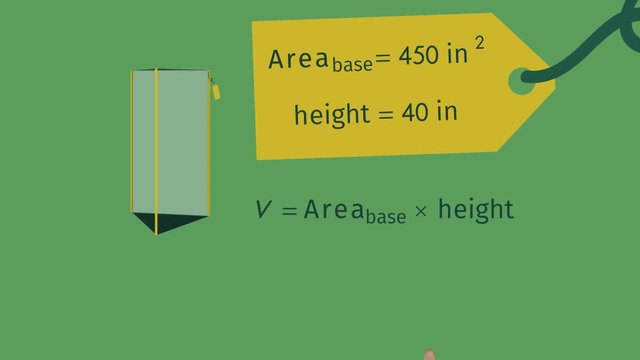Parts of Areas and Circumferences of Circles
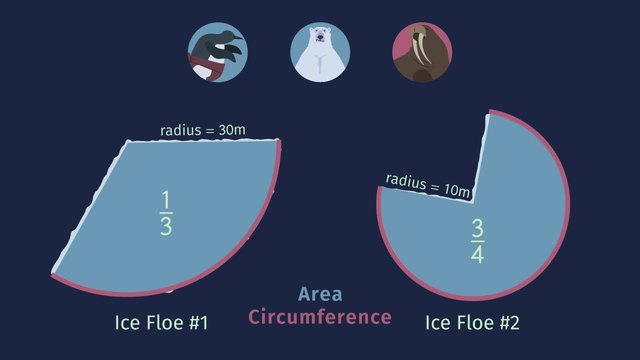
Basics on the topic Parts of Areas and Circumferences of Circles
When dealing with a fractional part of a circle, called a sector, multiply the fraction by πr² to get its area or by 2πr to get its circumference. A knowledge of parts of areas and circumferences of circles plays a major role in an architect’s design of a dome that is essential in terms of determining material requirement and ensuring safety. This also comes in handy in creating graphic designs and is always put into consideration when constructing curves and arcs in amusement parks. Learn how to compute for areas and circumferences of sectors by helping the event coordinators of the 5th Annual Polar Games find suitable ice floe locations for the Penguin Sumo Wrestling, Polar Bear Figure Skating, and Walrus Swimming events. Common Core Reference: CCSS.MATH.CONTENT.7.G.B.4
Transcript Parts of Areas and Circumferences of Circles
The world’s greatest polar animals from the north and south poles are gathering once again in Antarctica for the 5th Annual Polar Games. During the opening ceremony, some of the event coordinators are still trying to find a suitable location for a few events. Luckily, they find two ice floes that may work. Both of them are in the shape of parts of circles, also known as sectors. To help the organizers decide which ice floe to use, they'll have to know about the parts of areas and circumferences of circles. There are three events: Penguin Sumo Wrestling, Polar Bear Figure Skating, and Walrus Swimming. The most important value for the Penguin Sumo Wrestling and Polar Bear Figure Skating events is the surface area of the ice floes. But in Walrus Swimming, since they race along the outside of the ice, they'll need to know how long the circumference of the ice floe is. Ice Floe 1 is ⅓ of a circle with a radius of 30 meters. Ice Floe 2 is ¾ of a circle with a radius of 10 meters. Let’s first calculate the area of Ice Floe 1. The formula to find the area of a circle is pi 'r' squared. When calculating the area of a sector, we multiply the area of the circle by the fraction of the circle we want to calculate. Since Ice Floe 1 is a third of a circle, the area of this ice floe is one third times pi times the radius squared. We can substitute in 30 meters for the radius and, using 3.14 for the approximation of pi, gives us a value of about 942 square meters. Now let’s calculate the area of Ice Floe 2. This time, we use three fourths for the fractional value and 10 meters for the radius. And using 3.14 for the approximation of pi, gives us a value of about 235.5 square meters. We can see that the organizers should use Ice Floe 1 for Polar Bear Figure Skating, since they need more area for all the jumps and turns and Ice Floe 2'll be used for Penguin Sumo Wrestling. Now, we just need to figure out which ice floe to use for Walrus Swimming. Remember, the circumference of the ice floe is the most important factor for this event. So let’s measure the two circumferences. First, we look at Ice Floe 1. The formula to find the circumference of a circle is 2 pi 'r'. Because the diameter is exactly two times the radius, you may see circumfence also written as pi 'd'. Just like with area, the circumference of part of a circle is the fractional part of the circle multiplied by the circumference of the entire circle. So, to find the circumference of Ice Floe 1, we need to multiply one third times two times pi times the radius. Substituting 3.14 for pi, and 30 meters for the radius just like we did before, we get approximately 62.8 meters. And finally, for the circumference of Ice Floe 2. Remember, that the fractional part is 3/4 and the radius is 10. Just as before, we use 3.14 to approximate pi which gives us approximately 47.1 meters. Floe 1 is the better choice, especially if the race is 1000 meters long. We don't want the walruses getting dizzy! To review: the area of a circle is pi 'r' squared and the circumference of a circle is 2 pi 'r'. And the area and circumference of a part of a circle is the fractional part of the circle multiplied by the original formulas. Let's get back to the games already in progress. Just look how gracefully this polar bear skates! Look at that pirouette! ...uh oh...the polar bear is now an ice bear!
Parts of Areas and Circumferences of Circles exercise
-
Find the area of the sectors.
Hints$A_{\text{circle}} = ${$\pi~r^2$}, where $\pi\approx 3.14$ and $r$ the radius of the circle.
Don't forget about the units. Areas are $m^2$ or ...
SolutionFor the polar bear figure skating the coordinators need the largest area. The other area will be used for the penguin sumo wrestling.
So the coordinators have to determine the area of a part of a circle two times.
They need the formula for the area of circles:
$A_{\text{circle}}=\pi~r^2$.
with $\pi\approx3.14$ and $r$ the radius of the circle.
Because each ice floe is just a part of the circle, they have to multiply this formula by the corresponding fraction.
Let's start with ice floe number $1$:
$A_{Floe1}=\frac13~\pi~r^2$.
Plugging in the given values ($\pi\approx 3.14$ and $r=30~m$) we get
$\begin{array}{rcl} A_{Floe1}&=&\frac13(3.14)(30)^2\\ &=&\frac13(3.14)(900)\\ &\approx&942 \end{array}$
The area of ice floe number $1$, which is what we were looking for, is $942~m^2$.
In a similar way we can determine the area of ice floe number $2$. Here we have to multiply the area formula by $\frac34$:
$A_{Floe2}=\frac34~\pi~r^2$.
Again we plug in the given values for $\pi$ and $r=10~m$
$\begin{array}{rcl} A_{Floe2}&=&\frac34(3.14)(10)^2\\ &=&\frac34(3.14)(100)\\ &\approx&235.5 \end{array}$
The area of ice floe number 2 is $235.5~m^2$.
Thus the coordinators decide to take ice floe number $1$ for the polar bear figure skating and number $2$ for the penguin sumo wrestling.
-
Find the circumferences of the sectors.
Hints$C_{\text{circle}}=${$2~\pi~r$}, where $\pi\approx 3.14$ and $r$ is the radius of the circle.
Don't forget about the units. The circumference of a circle is a length, which in this case will be given as $m$, and in other cases could be $ft$, $km$, or $mi$.
SolutionThe coordinators of the games have a lot of work to do. Now, for the walrus swimming event, they have to find out which sector has the longest circumference.
Therefore, they have to determine the circumferences for both ice floes.
Fortunately, they know the formula for the circumferences of circles:
$C_{\text{circle}}=2~\pi~r$,
with $\pi\approx3.14$ and $r$ the radius of the circle.
Because each ice floe isn't a whole circle (it's just a part) they have to multiply this formula with the regarding fraction.
They start with ice floe number $1$:
$C_{Floe1}=\frac13~2~\pi~r^2$.
Plugging in the given values ($\pi\approx 3.14$ and $r=30~m$) they get
$\begin{array}{rcl} C_{Floe1}&=&\frac13(2)(3.14)(30)\\ &=&\frac13(3.14)(60)\\ &\approx&62.8 \end{array}$
The circumference of ice floe number $1$ is $62.8~m$.
They just have to determine the circumference of ice floe number $2$. For this they multiply the circumference formula by $\frac34$:
$C_{Floe2}=\frac34~2~\pi~r^2$.
Finally they plug in the given values for $\pi$ and $r=10~m$:
$\begin{array}{rcl} C_{Floe2}&=&\frac34(2)(3.14)(10)\\ &=&\frac34(3.14)(20)\\ &\approx&47.1 \end{array}$
This gives them the circumference of ice floe number 2 as approximately $47.1~m$.
Wow, they got it. They decide to use ice floe number 1 for the walrus swimming event because it has a longer circumference.
The games will start.
-
Decide which ice floe has enough area to house the Polar Games Village.
HintsUse the approximate value $\pi\approx 3.14$.
Each time you have to multiply the area formula
$A_{\text{circle}}=\pi~r^2$
by the given fraction.
Just two ice floes are suitable.
SolutionWe use the formula for the area of a circle
$A_{\text{circle}}=\pi~r^2$
Each time we have to multiply this formula by the given fraction.
$~$
Ice Floe #1
$A_{\text{Floe1}}=\frac12~\pi~r^2=\frac12(3.14)(20)^2=628$
Great, this ice floe is suitable because the area $628~m^2$ is larger than $527~m2$.
$~$
Ice Floe #2
$A_{\text{Floe2}}=\frac23~\pi~r^2=\frac23(3.14)(15)^2=471$
Too bad, this area $471~m^2$ is less than they require.
$~$
Ice Floe #3
$A_{\text{Floe2}}=\frac25~\pi~r^2=\frac25(3.14)(20)^2=502.4$
This floe isn't suitable either. The area $502.4~m^2$ is to small.
$~$
Ice Floe #4
$A_{\text{Floe4}}=\frac34~\pi~r^2=\frac34(3.14)(15)^2\approx 530$
Awesome. This ice floe, with an area of $530~m^2$, is suitable for the village.
$~$
Ice Floe #5
$A_{\text{Floe5}}=\frac14~\pi~r^2=\frac14(3.14)(25)^2\approx 491$
Sorry, that's not large enough. The village can't be build on this ice floe.
-
Calculate the area of the stadium seating.
HintsThe circumferences of the sectors are already given.
Take care of the measures: The circumference is a length and thus has the measure $m$ or ...
Just multiply the given circumferences by the corresponding fraction.
SolutionWe already know the circumferences of the ice floes:
- $C_{\text{Floe1}}=62.8~m$
- $C_{\text{Floe2}}=47.1~m$
- Regarding to ice floe #1 we get $\frac16\times 62.8~m=10.47~m$.
- The length corresponding to ice floe #2 is given by $\frac38\times 47.1~m=17.67~m$.
-
Recall the formulas for the area and circumference of both a circle and a sector of a circle.
Hints$A$ is the symbol for the area while $C$ stands for the circumference.
Pay attention to the meaning of the values
- $r$ is the radius of the circle.
- $d=2r$ is the diameter of the circle.
- $\pi\approx 3.14$
For area we can use units such as $m^2$ and for circumference we can use units such as $m$.
$r^2$ leads to the unit $m^2$.
SolutionHere are all the formulas you need.
- $r$ is the radius of the circle.
- $d=2r$ is the diameter of the circle.
- $\pi\approx 3.14$
- The area is given by $A_{\text{circle}}=\pi~r^2$ The units for the area are $m^2$ or ...
- The circumference is given by $C_{\text{circle}}=2~\pi~r=\pi~d$ The units for the circumference are $m$ or ...
For the given examples we get:
- The area of a third of a circle $A_{\text{sector of a circle}}=\frac13~\pi~r^2$
- The circumference of three quarters of a circle $C_{\text{sector of a circle}}=\frac34~2~\pi~r$
-
Solve for the circumference of the ice floe for the Dolphin sprint.
HintsUse the formula for the circumference of a circle.
$C_{\text{circle}}=2~\pi~r$.
Multiply the circumference formula by the corresponding fraction.
The smallest value is $26.17~m$ and the largest one $47.1~m$.
SolutionWe have to use formula for the circumference of a circle
$C_{\text{circle}}=2~\pi~r$
For each given ice floe we multiply this formula with the corresponding fraction. The ice floe are already in the right order:
Ice Floe #5
$C_{\text{Floe5}}=\frac16~2~\pi~r=\frac16(2)(3.14)(25)\approx 26.17$
The circumference of this floe is given by $26.17~m$.
Ice Floe #4
$C_{\text{Floe4}}=\frac14~2~\pi~r=\frac14(2)(3.14)(18)=28.26$
The circumference of this floe is given by $28.26~m$.
Ice Floe #1
$C_{\text{Floe1}}=\frac12~2~\pi~r=\frac12(2)(3.14)(10)=31.4$
The circumference of this floe is given by $31.4~m$.
Ice Floe #2
$C_{\text{Floe2}}=\frac25~2~\pi~r=\frac25(2)(3.14)(15)=37.68$
The circumference of this floe is given by $37.68~m$.
Ice Floe #3
$C_{\text{Floe3}}=\frac35~2~\pi~r=\frac35(2)(3.14)(12)=45.216$
The circumference of this floe is given by $45.216~m$.
Ice Floe #6
$C_{\text{Floe6}}=\frac38~2~\pi~r=\frac38(2)(3.14)(20)=47.1$
The circumference of this floe is given by $41.7~m$.
So best the organizers should choose the ice floe#6 if it's still available.


